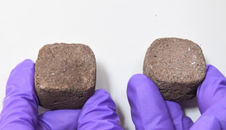

21st April 2022 (8 Topics)
Context
Researchers from the Indian Space Research Organisation (ISRO) and the Indian Institute of Science (IISc) have developed a way to make bricks from Martian soil with the help of bacteria and urea.
About
About bricks made by ISRO and IISc:
- These ‘space bricks’ can be used to construct building-like structures on Mars that could facilitate human settlement on the red planet.
- The team first made the slurry by mixing Martian soil with guar gum, a bacterium called Sporosarcina pasteurii, urea and nickel chloride (NiCl 2).
- This slurry can be poured into moulds of any desired shape, and over a few days the bacteria convert the urea into crystals of calcium carbonate.
- These crystals, along with biopolymers secreted by the microbes, act as cement holding the soil particles together.
- This method ensures that the bricks are less porous, which was a problem with other methods used to make Martian bricks.
- The bacteria seep deep into the pore spaces, using their own proteins to bind the particles together, decreasing porosity and leading to stronger bricks.
- In the past, the team had made bricks out of lunar soil using a similar method.
- However, the previous method could only produce cylindrical bricks, while the current slurry-casting method can also produce bricks of complex shapes.
- Another challenge was the composition of Martian soil, which has a lot of iron that causes toxicity to organisms.
- In the beginning, our bacteria did not grow at all.
- Adding nickel chloride was the key step in making the soil hospitable to the bacteria.

Future study:
- The team is now gearing up to investigate how the atmosphere in Mars combined with low gravity affects the ‘space bricks’.
- Martian atmosphere is a hundred times thinner than that of Earth’s, and contains over 95% carbon dioxide, which may significantly affect bacterial growth, stated the release.
- To recreate conditions on the red planet, researchers have constructed a device–MARS (Martian AtmospheRe Simulator).
- As per the release, the team has also developed a lab-on-a-chip device that aims to measure bacterial activity in micro-gravity conditions.
- The device is being developed keeping in mind our intention to perform experiments in micro-gravity conditions in the near future.


